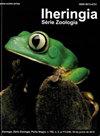Biometry of neotropical invertebrates inhabiting floodplain rivers: unraveling bionomy
IF 0.5
4区 生物学
Q4 ZOOLOGY
引用次数: 5
Abstract
ABSTRACT. Biometry of neotropical invertebrates inhabiting floodplain rivers: unraveling bionomy . Currently, it is widely recognized that invertebrates play key roles in neotropical floodplains and in many other environments worldwide. However, little information has been published concerning their biometry, in spite that it represents an essential tool for many different studies. Here, we provided length-mass and length-length relationships by fitting the linearized model (log 10 Y = log 10 a + b log 10 X) and several mean biomass ratios ± SE for bivalves, gastropods, quironomids, ephemeropterans, oligochaetes and hirudineans. We measured, weighed, oven dried and incinerated to ashes specimens collected from 2005 to 2014 in the Parana River, Argentina. The lineal equations had fit levels higher than 75% in most of the significant regressions. Hence, when slopes were compared, differences raised from ontogeny and phylogeny of taxa. Additionally, slopes resulted different from constants of other regions, types of environments and climates. In addition, significant differences were obtained in relation to feeding types of invertebrates when organic matter ratios were assessed. The equations and ratios that we provided will facilitate future research on life history, productivity and energy transference in the food webs of invertebrates inhabiting floodplain wetlands and can be used as tools for planning management strategies and in restoration projects of aquatic environments.居住在洪泛区河流的新热带无脊椎动物的生物计量学:解开生物学
摘要居住在洪泛区河流的新热带无脊椎动物的生物计量学:解开生物学。目前,人们普遍认识到无脊椎动物在新热带洪泛平原和世界上许多其他环境中发挥着关键作用。然而,关于它们的生物计量学的信息很少,尽管它代表了许多不同研究的基本工具。本文通过拟合线性化模型(log 10y = log 10a + b log 10x)和双壳类、腹足类、角形类、ephemeropterans、寡毛纲类和水蛭类的平均生物量比±SE,给出了长度-质量和长度-长度关系。我们对2005年至2014年在阿根廷巴拉那河收集的标本进行了测量、称重、烘箱烘干并焚烧成灰烬。在大多数显著回归中,线性方程的拟合水平高于75%。因此,当坡度比较时,差异来自于分类群的个体发育和系统发育。此外,坡度与其他地区、环境类型和气候的常数不同。此外,在评估有机质比率时,无脊椎动物的摄食类型也存在显著差异。我们提供的方程和比率将有助于未来对生活在洪泛平原湿地的无脊椎动物食物网的生活史、生产力和能量转移的研究,并可作为规划管理策略和水生环境恢复项目的工具。
本文章由计算机程序翻译,如有差异,请以英文原文为准。
求助全文
约1分钟内获得全文
求助全文
来源期刊

Iheringia Serie Zoologia
生物-动物学
CiteScore
1.00
自引率
0.00%
发文量
12
审稿时长
6-12 weeks
期刊介绍:
The journal Iheringia, Série Zoologia, edited by the “Museu de Ciências Naturais” of the “Fundação Zoobotânica do Rio Grande do Sul”, publishes original research findings in zoology with emphasis on taxonomy, systematics, morphology, natural history, and community or population ecology of species from current Neotropical fauna. Scientific notes will not be accepted for publication. Species lists without a taxonomic approach, or that are not the result of studies on the ecology or natural history of communities will not normally be accepted. The same applies to identification keys of groups of taxa defined by political boundaries. Authors wishing to inquire about the scope of the journal or the suitability of a particular topic are encouraged to contact the Editorial Board prior to submission. Furthermore, articles with a main focus on agronomy, veterinary, zootechny or other areas involving applied zoology will not be accepted.
Its abbreviated title is Iheringia, Sér. Zool., which should be used in bibliographies, footnotes and bibliographical references and strips.
 求助内容:
求助内容: 应助结果提醒方式:
应助结果提醒方式:


